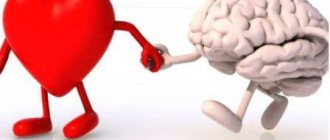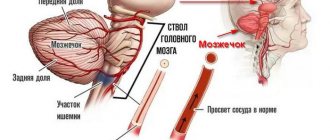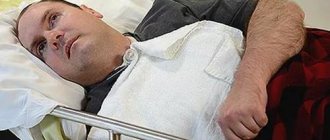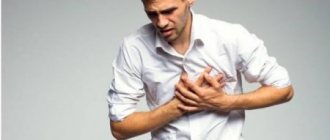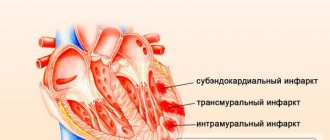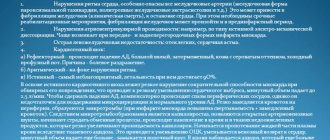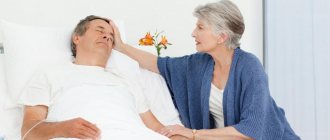A heart attack and stroke are hemorrhages that cause the body to stop functioning normally. The only difference between these concepts is that during a heart attack, hemorrhage occurs in the heart, and during a stroke, in the brain.
Heart attack and stroke are not instantaneous phenomena. If you pay attention to certain symptoms in time and provide the person with the necessary first aid (before the ambulance arrives), you can save the person not only from disability, but even from death.
But in order not to get confused and to properly provide assistance in case of heart attack and stroke, you first need to know the symptoms of their development.
Providing first aid for stroke and heart attack
MAIN SIGNS OF ACUTE CEREBRAL CIRCULATION DISORDER:
- 1. Facial distortion and/or drooling on one side when asked to smile; 2. speech disorders: difficulties in selecting the right words, understanding speech and reading, slurred and unclear speech, up to complete loss of speech when asked to speak;
- 3. numbness, weakness or paralysis (immobilization) of an arm, leg, half of the body when asked to raise your arm;
- 4. impairment or loss of vision, double vision, difficulty focusing;
- 5. impaired balance and coordination of movements (feelings of “swaying, sinking, body rotation, dizziness”, unsteady gait up to falling);
- 6. unusually severe headache (often after stress or physical exertion);
- 7. confusion or loss of consciousness, uncontrolled urination or bowel movements.
WHAT CAN YOU DO
:
CALL AN AMBULANCE IMMEDIATELY, EVEN IF THESE MANIFESTATIONS OF THE DISEASE HAVE ONLY BEEN OBSERVED FOR A FEW MINUTES!
03 – for landline phones,
103 – for landline and mobile phones.
BEFORE THE ARRIVAL OF THE AMBULANCE Crew:
- 1. If the patient is unconscious,
lay him
on his side
, remove removable dentures (food debris, vomit) from the mouth,
make sure that the patient is breathing.
2. If the victim
is conscious
, help him take a comfortable
sitting or semi-sitting position
in a chair or on a bed, placing pillows under his back.
- 3. Provide fresh air. Unbutton your shirt collar, belt, belt, remove tight clothing
- 4. Measure your body temperature. If t=38° or more, give the patient 1 g of paracetamol.
- If paracetamol is not available, do not give other antipyretic drugs! If the victim cannot swallow, drugs are not given.
5. If the patient has previously taken drugs that lower blood cholesterol from the statin group, give the patient the usual daily dose.
6. If the victim has difficulty swallowing and saliva drips from his mouth, tilt his head towards the weaker side of the body, blot the flowing saliva with clean napkins
.
- If the victim is unable to speak or has slurred speech, reassure and reassure him that the condition is temporary.
- That only emergency medical care called in the first 10 minutes
from the onset of a heart attack or acute cerebrovascular accident
allows for the full use of modern highly effective methods of hospital treatment and many times reducing mortality from these diseases. - That the state of alcohol intoxication is not a reasonable basis for delaying calling an ambulance in the event of a heart attack and acute cerebrovascular accident
- about 30% of people who died suddenly at home were intoxicated.
- Hold the victim's hand on the non-paralyzed side, stop attempts to talk and Don't ask questions that require an answer.
REMEMBER!
- That closed cardiac massage, performed in the first 60-120 seconds
after sudden cardiac arrest, allows up to 50
%
of patients to be brought back to life.
- Be healthy!
Signs of a stroke - what they are and how to identify them
You can recognize a stroke by asking the victim to do the following:
- Raise both arms up. If he has a stroke, he simply will not be able to do this simple action.
- Say any simple phrase, for example: “The weather is disgusting today.” If a person has a stroke, then he will either greatly distort it or will not be able to repeat it at all
- Stick out tongue. You should be alerted if the patient's tongue is curved or turned to the side
- Ask the victim to smile. During a stroke, the smile should curl to one side of the mouth
If you notice at least 2 of the symptoms listed above, call an ambulance immediately. Most likely it's a stroke!
The following symptoms may also signal an approaching stroke:
- Severe dizziness
- Fainting
- Loss of balance
- Unexpected severe headache
- Numbness in an arm or half of the body
- Severe visual impairment
- Slow or slurred speech
- Confusion
What to do in case of a stroke before the ambulance arrives
Before the doctor arrives, the victim must be positioned so that his head and shoulder blades are on a pillow approximately 45 degrees above the body.
It is also important to provide the patient with access to fresh air. To do this, you can open the window and unbutton the patient’s clothes.
If the patient experiences nausea, turn him on his side. If you have dentures, you need to take them out (here we talk about caring for dentures).
Give the patient water. It is needed to thin the blood. To calm his nerves, you can give him a glycine tablet under his tongue.
Measure your pulse and blood pressure every 10 minutes. If your blood pressure is high, try to correct it by holding your breath.
What absolutely should not be done during a stroke
Try to carefully study and remember the following information. It is very important, since inept actions can greatly complicate the patient’s condition during a stroke. So here are the 6 DON'Ts you need to remember:
- You cannot revive a patient using ammonia. There is a danger that he will lose his breath
- If you have a stroke, you should not give the patient diuretics or drugs that sharply lower blood pressure. There is a risk that he will be paralyzed! Hypertensive patients can be given medications that are familiar to them, in their usual dosage.
- You should not give the patient drugs such as: nosh-pa, papaverine, etc. All of them have the properties of dilating blood vessels, which is why blood from one area of the brain can spread to an undamaged area
- Do not feed the patient, as vomiting may result in aspiration and respiratory arrest.
- During a stroke, the patient should not be allowed to stand up. There is a risk that pressure will rise, including intracranial
- You cannot make concessions to a patient. If he says he feels better, just ignore it. A person’s brain function is impaired and he simply cannot adequately assess his condition. The best way out in this situation is to wait for a doctor
What is the difference between a heart attack and a stroke
The heart and brain are the main parts of our body. Its normal functioning depends on them. Statistics show that heart attack and stroke are very common diseases that often lead to death.
To save a person, you need to know what to fight. Heart attack and stroke are diseases that are often encountered in the modern world. And sometimes each of us can save someone's life. After all, anyone can meet a person on the street who has suddenly staggered or grabbed his heart. But not everyone knows what needs to be done in this situation.
The first signs of a heart attack
To prevent complications, you should listen to your body, detect the first signs of a heart attack and prevent its development.
The first signs include:
- The appearance of snoring, sudden cessation of breathing;
- Bleeding from the gums, their soreness;
- Swelling of the feet and legs;
- The appearance of arrhythmia;
- Soreness radiating to the left shoulder;
- Breathing problems
- Constant headaches;
- Frequent visits to the toilet at night.
29.09.2016
Stroke: causes, symptoms and classification
A stroke is an acute disorder of blood circulation in the brain, which leads to damage to brain activity. The most common and common signs of a stroke:
- Weakness in the arms or legs, feeling as if one of the limbs was being taken away.
- One side of the face looks unnaturally distorted.
- A person may have little understanding of what is happening and what he is doing.
- Speech becomes slurred and vision deteriorates.
- My head suddenly starts to feel dizzy.
It is impossible to make such a diagnosis right away; it is necessary to undergo a series of tests and undergo an examination.
Causes of stroke
There are three main causes of stroke:
- Arterial hypertension,
- IHD (ischemia),
- Atherosclerosis.
Their manifestation is facilitated by poor diet, smoking, frequent alcohol consumption, frequent stress and much more. Among women, the most common factor that can lead to stroke is obesity, and in men, alcoholism.
Types of stroke
There are 2 types of stroke:
- Ischemic, which can be caused by a blood clot formed in the heart; elements of an atherosclerotic plaque or vascular spasms.
- Hemorrhagic, which is characterized by bleeding into the brain, into the cerebral membranes, into the ventricles of the brain, or mixed.
The latter is usually more serious and develops faster. Common symptoms include vomiting, headaches, and nausea. Numbness of the arms and legs appears, muscles weaken.
The eye may squint, the corner of the mouth may go down, one side of the face may lag behind the other in facial expressions. Sensitivity may decrease or disappear altogether.
Stroke treatment
Stroke treatment is carried out according to one principle, which consists of performing the following stages: timely emergency care, inpatient treatment, rehabilitation in a special center (sanatorium). Let's learn more about each of the stages.
What an “involuntary witness” should do was discussed above. Now we will learn about the actions upon the arrival of an ambulance. First of all, the specialist determines the degree of neglect of the disease. His main task is to accompany the patient to the hospital for further inpatient treatment in the intensive care unit.
Directly when transporting a patient:
- The doctor needs to obtain information about your blood pressure. Read about whether a stroke can occur with normal blood pressure here.
- Introduce medications that restore the functioning of the cardiac system and normal breathing.
- Also, ambulances do not have the right to transport patients in a coma with impaired blood supply to the brain and critical condition of other internal organs. In this case, the treatment team leaves the medical institution.
Treatment in a hospital begins with intensive care . Patients should initially be examined by a neurologist and neurosurgeon. Depending on the advanced stage of the disease, the severity of the patient’s condition and the type of stroke, further treatment is carried out.
Ischemic stroke
In general, the main tasks of therapy specialists are:
- Normalization and improvement of blood circulation and oxygen saturation of brain cells;
- Increase resistance to oxygen deficiency in every possible way;
- Use medications that increase the metabolism of unaffected tissues.
The patient is placed on the bed with his head raised slightly higher than his body. Medications that dilate blood vessels must be used. Particularly important are collaterals , which have substitution functions. Droppers are used.
The administration of fluids must be controlled, as they can cause increased swelling of the brain. Diuretics must also be used at the same time ; in case of hypertension, they are used with extreme caution. If the patient experiences increased arousal, barbiturates .
Hemorrhagic stroke
Goal of therapy:
- Eliminate swelling of brain cells;
- Reduce blood pressure and intracranial;
- Strengthen blood clotting and increase the density of vessel walls.
The patient is transferred to a special bed. The head is located much higher than the body, and a heating pad filled with ice is applied to it. The feet are covered with heating pads with boiling water. It is necessary to relax the muscles; to do this, the bend in the knees increases or a bolster is placed under the knees.
In the treatment of this type, all medications are aimed at increasing coagulation and promoting vascular thrombosis. Throughout treatment, the blood is constantly checked for a coagulogram. If severe swelling is present and is accompanied by meningeal symptoms, puncture in order to extract a large amount of cerebrospinal fluid.
Stroke treatment can also be carried out in the neurosurgery department through surgery. This treatment is applied only to patients in young and middle age, when there are lateral hematomas and blood infusion into the cerebellum.
Indications for this method are:
- Without effective relief of swelling with medications and other methods;
- The appearance of signs of tissue compression by a hematoma;
- There is a suspicion of re-infusion of blood into the brain.
The main treatment is on the first day , when operations are carried out without delay. Doctors open the hematoma cavity and remove its contents by puncture. At the same time, it is necessary to remove blood clots. If necessary, vascular ligation is performed.
Drugs and traditional methods of treating stroke
In the treatment of ischemic stroke, the main ones are droppers:
- The following drugs are used:
- Eufillin;
- No-shpa;
- Papaverine;
- A nicotinic acid;
- Complamin.
- To improve microcirculation:
- The use of Reopoliglucin, which increases blood circulation through its effect on coagulation, is prescribed.
- Fibrinolysin and Heparin must be administered on the day of admission.
- Also after this it is necessary to use Heparin intramuscularly, and after 3-5 days - Phenilin, Dicumarin.
- Young and middle-aged patients : Pentoxifylline is prescribed to increase blood density.
- For the elderly it is necessary to use:
- Parmidina;
- Xanthinol;
- Nicotanata;
- if there is tachycardia - Anaprilin.
- Vascular tone can be increased with Cavinton and Cinnarizine.
- To prevent a recurrent stroke, Curantil is prescribed simultaneously with Aspirin (Thromb Ass, Cardiomagnyl).
- To improve metabolism and increase tissue resistance, use:
- Piracetam;
- Aminalon;
- Cerebrolysin.
- Hemorrhagic stroke requires, first of all, a decrease in blood pressure through intravenous drips:
- magnesia sulfate;
- Dibazole or Aminazine;
- Pentamina.
- For the first 2-3 days it is necessary to use:
- Calcium chloride;
- Vikasola;
- Aminocaproic acid.
- On the third day, you can use Gordox or Contrical with Heparin.
- To stop bleeding and increase microcirculation, we use Etamsilate.
Treatment with folk remedies involves the use of special plants, physical exercise and massage, as well as proper nutrition. Traditional medicine is often used in combination with drug treatment for greater effectiveness.
The most effective in the treatment of stroke are considered to be infusions of pine and fir cones, which are available in pharmacies or can be prepared independently.
Read more about pine cones in our similar article.
Herbal infusions often used during the rehabilitation period are:
- Sage – restores speech;
- Plantain , yarrow, St. John's wort, walnut, eyebright, strawberry, calendula flowers, agrimony;
- Celandine;
- Dioscorea Caucasica;
- Thyme for rubbing against paralysis;
- Juniper for rubbing and taking orally for paralysis.
What is a heart attack and its symptoms
Unlike a stroke, a heart attack is caused by the formation of a blood clot, causing part of the heart to die. A heart attack can be microscopic, small, medium and large. There is a primary heart attack, which happened for the first time, and a recurrent one - this is a recurring heart attack.
Symptoms of a heart attack
A characteristic symptom is chest pain that lasts for 20 minutes. Feeling as if something is pressing and squeezing inside. Possible loss of consciousness, vomiting, nausea, fear and emotional excitability.
The person begins to lose strength, shortness of breath appears, pain spreads to the left side of the neck and shoulder blades, lower jaw, and arm.
To establish the disease, an ECG is necessary. Blood biochemistry will also be required.
First aid for heart attack
If you suspect a heart attack, you should stop any activity, sit down and, if possible, put a nitroglycerin tablet under your tongue. If after 15 minutes the pain intensifies, lay the patient down with his head raised.
Next - 0.25 nitroglycerin and 0.25 aspirin, chew and swallow. Ensure fresh air enters the room: open windows, balconies, and vents as much as possible. If the situation has not changed after 5 minutes, immediately call an ambulance. It is worth knowing that you should not use the tablet more than three times.
If you suspect a heart attack, you should not eat, smoke, walk or stand up.
The first signs of myocardial infarction: when to take action?
Myocardial infarction is an acute condition that occurs due to coronary heart disease and is accompanied by severe circulatory failure in the coronary vessels and necrosis of part of the heart muscle tissue. In 10–12% of cases it is life-threatening for the patient. More often, heart attacks occur in men over 60 years of age, but after menopause, women are also at risk. In recent years, there has been a significant “rejuvenation” of this condition and the development of anesthesia of the heart muscle in 20-30 year old young people is observed more and more often.
In 90% of patients with coronary artery disease, a heart attack is provoked by coronary artery thrombosis caused by atherosclerosis. The following reasons can also provoke coronary circulatory insufficiency:
- thrombosis and spasm of coronary vessels;
- heart injuries;
- tumors or metastases.
- The risk group for developing a heart attack includes people with the following pathologies and conditions:
- atherosclerosis;
- hypertonic disease;
- obesity;
- diabetes;
- increased levels of LDL in the blood;
- adynamia;
- bleeding disorders;
- smoking and alcoholism;
- excessive psycho-emotional and physical stress.
Usually the attack begins suddenly, but in some patients there may be a pre-infarction condition, manifested by an increase in temperature, tachycardia and arrhythmia, cyanosis of the mucous membranes, severe pallor, an increase in blood pressure with its subsequent decrease. This condition can last from several hours to several days or weeks.
The main sign of a heart attack is severe pain in the chest, which is prolonged. It differs from the pain that occurs with angina pectoris in that it manifests itself for more than 15 minutes and is not eliminated even by repeated administration of Nitroglycerin. Usually pain occurs after physical or psycho-emotional stress.
Immediate first aid actions for a heart attack should be performed immediately after the following symptoms occur:
- severe and prolonged pain behind the sternum of a burning, stabbing, tearing, squeezing nature (it is present for half an hour and is not eliminated or is only partially relieved by the usual intake of Nitroglycerin);
- severe anxiety and fear of death;
- pain radiates to the left (sometimes to the right) arm, shoulder blade, interscapular area, neck, teeth;
- cold clammy sweat;
- dizziness or fainting;
- pallor;
- nausea;
- difficulty breathing and shortness of breath (sometimes);
- rapid and arrhythmic pulse.
In approximately 20% of cases, myocardial infarction occurs in an atypical form and is not accompanied by pain in the heart area. In such cases, symptoms may be as follows:
- with an atypical location of pain - it is concentrated in the left hand, at the tip of the little finger of the left hand, in the cervicothoracic spine or in the scapula, in the area of the lower jaw or neck, the pain syndrome is complemented by typical manifestations of a heart attack;
- with the gastric type of attack - indigestion and abdominal pain;
- with asthmatic – shortness of breath and suffocation, dry cough;
- with arrhythmic – rapid and arrhythmic pulse;
- with cerebral – confusion, dizziness, nausea and vomiting, speech disorders;
- with edema – severe weakness, shortness of breath, rapid increase in edema;
- if painless - discomfort in the chest, weakness, increased sweating.
The first signs of a heart attack and any suspicion of its development are a reason to call an ambulance. The operator must be informed about the symptoms and the possibility of a heart attack. After this, you should immediately begin providing pre-hospital emergency care.
What is the difference between a stroke and a heart attack?
From the above we can conclude that a stroke affects the brain, and a heart attack affects the heart. In case of a heart attack, it is necessary to act immediately; the disease strikes at a faster rate than with a stroke.
But cardiovascular diseases can be controlled and even avoided if you follow the lifestyle prescribed by your doctor and follow all the recommendations. As a rule, such diseases do not appear unexpectedly, so the patient should be aware of the possible consequences.
The similarity between a heart attack and a stroke is that the condition changes at incredible speed for the worse. The difference is that a heart attack can be triggered by extreme stress or physical activity. A stroke, as a rule, is not preceded by anything.
The assistance that should be provided when such situations arise also differs. If you see a suspected heart attack, do not move the person under any circumstances; in direct sunlight, provide a canopy. The maximum that can be done is to raise your head a little and give aspirin, if available.
If possible, talk and keep the patient conscious, find out what happened, and immediately call an ambulance.
During a stroke, the main thing is not to let the patient drink or eat, put him in a comfortable position, and loosen his collar or tie, if any. It’s even better to lay it on your side so that you can breathe easier. Also call an ambulance.
With any of these options, call the doctors as soon as possible, wait for them, and tell them in detail what you found out and did.
After a heart attack
After discharge from the clinic, the patient after myocardial infarction must follow the following rules:
- No smoking. The bell has already rung. The heart is not such a large organ that it is easy to part with its cells.
- Reduce cholesterol. Diet based on the “meat to fish” principle, as well as high doses of statins. A patient after a heart attack should have “below low” cholesterol (level of “bad” cholesterol - LDL <1.8 mmol/l).
- Take two antiplatelet drugs (aspirin and clopidogrel) for 12 months, followed by aspirin for life. Platelets should not come within a shot of a cannon shot of the affected area.
- Take beta blockers and ACE inhibitors. In this case, these are not only “pressure medications,” but also medications that protect the heart from structural and “electrical” changes caused by myocardial infarction.
- Reduce pressure. If beta blockers and ACE inhibitors are not enough, then the doctor will definitely recommend additional medications to maintain blood pressure at <140/90 mmHg. Art.
Now for the good news. If a doctor treats a patient who has suffered a myocardial infarction well, and the patient, in turn, carefully follows the recommendations, then the patient can:
- Return to work and an active lifestyle.
- Do physical education.
- Fly airplanes and travel.
- Have an active sex life.
In a word, for most patients, myocardial infarction is not a “sentence”, but an alarming signal that makes you think that the heart and blood vessels require careful treatment.
First aid for stroke
During a stroke, blood circulation in an area of the brain is suddenly disrupted - hemorrhage and spasm occur. The person loses consciousness and the ability to move. More than 30% of survivors require special care, 20% cannot move without assistance. About 8% return to a full life. The faster medical assistance is provided, the greater the victim’s chances of restoring maximum performance.
- The victim experiences a sudden severe headache, then weakness, cannot stand or sit, and loses consciousness.
- Vomiting begins, preceded by nausea.
- Half of the face goes numb, the mouth is distorted, the victim cannot speak, has difficulty hearing and seeing.
- Half the body stops moving.
A person who has just had a stroke cannot smile - the muscles in one part of the face practically do not work. He is unable to give a coherent answer to a simple question (say his name, profession), or raise both arms at the same time - the muscles of one half of the body are not working well.
First aid for stroke
First aid for a stroke begins with facilitating breathing. Open the windows, the window, unbutton your clothes. Try to calm the victim. Lay him down, raise his head about 30º. If possible, measure your blood pressure. Write down the time and measurement result, perhaps on the victim itself, for example on the hand. If breathing or heartbeat stops, immediately begin cardiopulmonary resuscitation.
It is forbidden:
- give water and food to the victim;
- give vasodilators;
- hold the victim when convulsive or epileptic seizures begin. Try to prevent him from hitting a corner or glass during a seizure, place a pillow or cloth, remove foam coming from the mouth, insert something between the jaws so that the person does not bite his tongue;
- carry the victim during a seizure.
First aid for cardiac arrest
The coordinated work of the heart muscles is disrupted for various reasons, for example due to electric shock. Most often (in 90% of cases) ventricular fibrillation is observed. In this condition, the myocardial fibers contract chaotically and the heart loses its ability to pump blood. 10–20 seconds after cardiac arrest, the person loses consciousness, breathing becomes rare, agonal, and the pupils dilate after 2 minutes.
- no pulse. The presence of a pulse is checked in the neck, wrist, under the knees, in the groin area, and at the top of the foot. Note the time and count the number of heartbeats. When checking to see if the victim has a pulse, make sure you do not feel your pulse instead. Be sure to evaluate other signs;
- lack of breathing. See if the chest moves. You can put your hand on the abdominal area - if there is breathing, you will feel movements. Bring a mirror, phone, tablet, or other surface that can fog up when you breathe to the area of your nose and mouth;
- lack of pupil reaction to light. The situation is bad if the pupils are unnaturally dilated, do not narrow when light is directed at them (for example, from a flashlight on a phone), and when pressing on the eyeball from opposite sides, they narrow in the form of a “cat’s pupil”;
- unnatural complexion. With insufficient blood circulation, the face turns pale, gray, and cyanotic.
First aid for cardiac arrest
- Lay the victim flat on his back on a hard, level surface. On the soft side, the victim will sway under your pressure, but you won’t “reach” the heart.
- Place your palms on top of each other horizontally in the middle of your chest: the palm of one hand is on the back of the other hand, fingers clasped. Straighten your arms.
- Press the victim’s chest with the heels of your palms so that it sags by 5–6 cm with a frequency of approximately 10 times every 5–6 s. Press with your body, not with your arms, because your arms will get tired quickly. You can “work” with your body for up to half an hour.
- If additional ventilation of the lungs is necessary, do 2 injections every 30 pressures.
- When a steady pulse and breathing appear, we stop cardiopulmonary resuscitation and turn the victim onto his side.
- For infants, we apply pressure with 2 fingers, for younger children - with 1 hand.
- hesitate. To return a person to a full life, you only have about 6–7 minutes, and it is unknown how many of them have already passed;
- stop resuscitation measures until the doctor’s verdict. If the ambulance travels longer than 10 minutes, first aid delays final cardiac arrest and increases the likelihood of successful defibrillation;
- try to carry out a precordial blow - hit the victim hard in the area of the xiphoid process to “start” the heart. This technique is effective only if it is mastered perfectly. Otherwise, you are highly likely to simply break the xiphoid process or rib. It’s better to immediately start “pumping” your heart.
So, now you know the rules of first aid for stroke and cardiac arrest.
How to recognize a stroke and heart attack in a person and provide him with first aid
Providing assistance before the ambulance arrives can save someone's life.
On the eve of World First Aid Day, KI asked Krasnodar doctors to tell us how to recognize a stroke and heart attack in a person and provide first aid.
The main mistake of Russian patients, which doctors are shouting about from all newspaper pages and TV screens, is procrastination. Late contacting a doctor, late calling an ambulance.
In some diseases, delay is not critical, but it can be fatal when it comes to stroke and heart attack. Therefore, signs of the development of these diseases
Everyone should know, even those who do not suffer from diseases of the circulatory system.
This knowledge may be useful if one of your relatives has problems with the heart and blood vessels. It is possible that you may witness the development of a stroke or heart attack in your colleague, a fellow traveler on public transport, or a random passerby. Your competent actions can save his life.
Advice from a cardiologist
And finally, I would like to give you some advice from myself. It’s mid-April now, and in just a little while, summer residents will start gardening. It was at this time that the flow of stroke patients, according to statistics, increases significantly.
This is due to the position in which people have to dig in the beds, planting, weeding, etc. This position of constantly tilting your head down poses an increased danger and often provokes a stroke.
How to be? After all, one cannot completely abandon working with the land, especially since it simply feeds many. Of course not. You just need to know the limits of the load.
Follow these simple recommendations when gardening and you will significantly reduce the risk of stroke:
- Never work in the heat
- Take a break every 2 hours
- All gardening tools must have long handles.
- When weeding beds, it is better to sit on a bench or at least squat, but not upside down
- Measure and monitor your blood pressure throughout the day
- Listen to your health so as not to miss the alarm bell. No one can do it better than you
That's all for me.
Now you know how to recognize the signs of a stroke and heart attack and what to do in this case. With you was Vera Mikhailovna Ilyukhina, a cardiologist and author of articles in the “Cardiovascular Diseases” section of the “Notes of the Village Aibolit” website. On average, it takes 3-4 hours to write 1 article. By sharing an article on social networks, you express gratitude to the blog authors for their work!!!
Stroke
“The word stroke came into medical and everyday speech from the Latin language,” says Lyudmila Antipova, head of the neurological center of the regional clinical hospital No. 2, chief neurologist of Krasnodar. “Insultare means “jump”, “jump”, and the disease really seems to “jump” into a person’s life and destroys it.”
The causes of stroke are:
– existing hypertension, – vascular atherosclerosis, – disturbed heart rhythm.
If you do not suffer from the above diseases and conditions, but a healthy lifestyle is not about you, then you are at risk.
Risk factors for stroke are:
– smoking, – alcohol abuse, – low physical activity, – unhealthy diet, which can lead to obesity.
People who neglect a healthy lifestyle are most likely to suffer from a stroke.
who hoped at random: anything can happen to someone, but not to me.
In most cases, stroke occurs in older people burdened with cardiovascular disease. However, today the trend towards an increase in stroke among young people and even children continues throughout the world.
Symptoms
A stroke can be recognized by the following symptoms:
– the face is distorted, – speech is impaired, – there is a severe headache, – there is unsteadiness when walking, – there is numbness and weakness of the limbs on one side.
One or more signs from this list are a reason to immediately call an ambulance.
If the patient lives alone and is able to independently measure his blood pressure and collect medical documents, he needs to do this before the ambulance arrives, so as not to waste time on this afterwards.
If this fails, he must find the strength to open the door to the medical team and, if possible, call one of the neighbors.
Do not take nitroglycerin under any circumstances, because you do not know what kind of stroke you are having - hemorrhagic (when a blood vessel ruptures and a cerebral hemorrhage occurs) or ischemic (when a cerebral vessel is blocked). This can only be determined by a doctor using a tomograph.
Symptoms of a stroke
- general weakness in the body;
- loss of sensation, most often on one side of the body;
- disorientation;
- partial impairment of oral speech;
- possible short-term blindness;
- difficulty swallowing;
- imbalance;
- dizziness;
- nausea;
- vomit;
- loss of consciousness.
If you or your loved ones have two or more symptoms, call an ambulance immediately.
When you talk to the dispatcher, try to describe the symptoms in as much detail as possible. In the meantime, you are waiting for the doctors to arrive, you can provide the victim with first pre-hospital emergency care.
Before the ambulance arrives
Now let’s find out what you should do if you witness a stroke:
- do not give the patient nitroglycerin, even if he insists on it, - take off his scarf, loosen his tie, unbutton the top buttons of his coat or shirt - in general, give him more air,
– sit or lay the patient on a bench or directly on the ground,
- call an ambulance and stay with the patient until it arrives: during a stroke, a person may vomit, and if he is unconscious, there is a danger of choking.
In addition, you will need to tell the medical team when you noticed a person with signs of a stroke, what condition they were in, and what your actions were before they arrived.
“If an ambulance is called for a patient in the first three hours from the onset of signs of a stroke, the chances of providing effective assistance are much higher,” continues Lyudmila Antipova.
– Modern technologies for treating stroke in Krasnodar make it possible to dissolve a blood clot in a vessel by administering a thrombolytic drug or remove a blood clot from a large artery if it has blocked the lumen of the vessel.
For this purpose, sophisticated modern technology and ultra-precise equipment are used, which are owned by x-ray endovascular surgeons.”
Heart attack
“Patients often confuse an approaching heart attack with heartburn, take medications that do not help them, but continue to endure pain,” notes with regret the city’s chief cardiologist, head of cardiology department No. 2 of the Krasnodar Clinical Emergency Hospital, Natalya Spyropoulos.
– If you know you have heart problems, take the medicine prescribed by your doctor. If it doesn’t help in a minute, call an ambulance immediately. The first 75 minutes from the onset of symptoms are important here.”
In the first hour, thrombolysis is performed, which will dissolve the clot and restore blood flow. Thus, a heart attack will pass for a person without consequences or with minimal “losses” - the scar on the heart will remain small.
But you need to understand that the part of the “engine” on which there is a scar no longer works. And the larger the scar, the smaller the area of contraction of the main muscle of the body. Hence – chronic heart failure and other serious diseases.
Myocardial infarction
How is it related to high blood pressure? Increased pressure damages the walls of blood vessels, causing dysfunction of the endothelium, the inner lining of blood vessels. Cholesterol easily “clings” to the damaged endothelium, forming a cholesterol plaque that narrows the blood vessels. This process is called “atherosclerosis”. The plaque grows, blood flow is disrupted, and angina occurs.
The most serious trouble occurs when suddenly, for example against the background of a hypertensive crisis, a plaque in the coronary artery ruptures, and platelets rush to this place. A blood clot forms and blood flow stops completely, which can lead to the death of the heart muscle.
Most often, myocardial infarction is manifested by severe chest pain, spreading to both shoulders and left arm, to the neck and lower jaw. At home, you cannot relieve this pain on your own—nitroglycerin, which is traditionally effective for angina, will not help.
Before the ambulance arrives
If a person complains of a sudden painful burning sensation in the chest, this is a heart attack. Next, as in the case of a stroke, you should free the patient’s throat, sit him down or lay him down, dial «03».
During both a stroke and a heart attack, try to keep the person conscious with a loud voice and soft pats on the cheeks.
If he does not have documents, ask his name, how old he is, what chronic diseases he has (diabetes, bronchial asthma, etc.), allergies, who to call. This information will help the medical team.
And further
If you see someone having an epileptic attack, do not put anything in their mouth. At the moment of an attack, the tongue becomes hard and cannot sink.
If you insert any object into the mouth, there is a risk that the patient will bite it or damage his teeth, and their fragments may get into his respiratory tract.
Until the attack ends, turn the person on their side to prevent them from choking if they vomit, and hold their head so that they do not hit it on the ground or floor. Immediately after the convulsions, he may fall asleep - this is a normal reaction of the body, do not wake him up.
